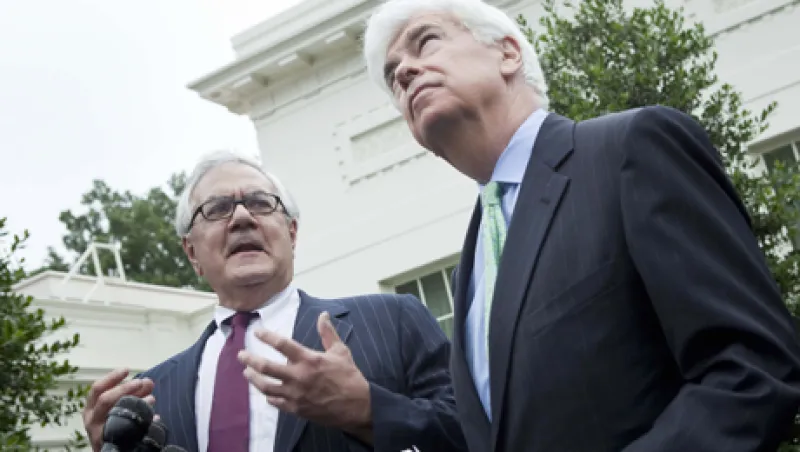While the debate over the impact of new regulations to the over-the-counter derivatives market continues apace, at least one technology provider says they have come up with a way to dramatically reduce systemic risk in this arena — they just need a Dodd-Frank exemption to make it happen.
Dodd-Frank is all about requiring the major banks to reduce the threat of systemic risk by raising the capital charges on their exposures to other banks — a function of their interconnectivity and the fact that in the OTC derivatives market prior to the 2008 financial crisis, there was a total lack of transparency in the bilateral trades and quantity of counterparty risk that accrued. It’s a huge problem that came to a head during the collapse of Lehman Brothers, and it’s what makes the financial system so very vulnerable during times of market stress.
One way that regulators in the U.S have taken steps to reduce risks in the OTC derivatives world — a $700 trillion market — is to require that clearing activity take place through a clearing house or central clearing counterparty (CCP) — a financial entity whose primary function is to guarantee the performance of derivatives contracts among its participants. Assuming that the CCP is sufficiently creditworthy, it has the ability to absorb the cost of unwinding positions or failed counterparties and can mitigate the possibility of contagion in the form of default risk, spreading quickly from one member to another.
But the push by regulators for a standardized OTC world where many trades are cleared centrally has its complications. The CCPs that exist — for example, LCH.Clearnet’s SwapClear and CME Group’s CME Clearing — tend to specialize in clearing specific types of asset classes rather than all asset classes, and in the end, the fragmentation in the OTC clearing arena means dealers have to hold more capital and post more collateral against exposures to multiple clearing houses. This does not include the capital they will also have to hold for the portion of their trades that continue to be bilateral in nature. In addition, for now, the centrally cleared model does not allow for firms to net their positions across all asset classes, a way to keep down collateral costs, nor does it efficiently facilitate netting for both cleared and bilateral trades.
It all makes for a complex and increasingly costly clearing situation. As John Jay, a derivatives analyst with Aite Group put it, “Some would say there is not enough collateral in the world to cover every single derivatives trade out there on every CCP.”
Enter TriOptima, a division of ICAP, the world’s largest interdealer broker and a provider of services that process OTC derivatives through its TriReduce business. The firm has devised a new, algorithm-based service called triBalance, designed to mitigate the new and increasingly complex, counterparty exposure risk.
In collaboration with nine active OTC derivative dealers, TriReduce has conducted a pilot test of the service that — the firm says — reduced the counterparty risk exposure of the participants’ portfolios of cleared and uncleared trades by 33 percent and generated an aggregated reduction of U.S. $2.7 billion in potential future exposure across the participants, assuming a 10 basis point move in interest rates. The exposure reduction would be even greater, the company says, during times of higher market volatility.
The triBalance service from TriReduce — designed for use by banks and broker dealers — comes at a time when The Bank for International Settlements has said that the move to clear all OTC derivatives centrally could actually exacerbate and further concentrate trading risk, while others have expressed concerns about the possibility of a CCP default and the suffering this could cause all market participants.
According to Peter Weibel, chief executive at TriReduce, individual positions in the CCPs have to be covered with initial margin first and then with variation margin as the positions are marked to market daily. “All of this is a drain on capital that could be used for other business activities and was not required in the bilateral world,” Weibel says. As these new demands on capital in the form of collateral increase due to exposures to the CCP, the new triBalance service is able to smooth out these exposures and reduce the demand for collateral and reduce the liquidity drain of initial margin.
It does so by employing a sophisticated algorithm that identifies an optimal risk-reducing set of rebalancing trades that offsets existing risk versus CCPs and bilateral counterparties simultaneously. The package of new trades that each institution then executes as a whole is market risk neutral for each participant. Thus far, the service has been tested for interest rate swaps but is applicable to credit swaps and can be used for commodity-based derivatives as well.
The algorithm takes into account each institution’s current risk exposure against CCPs and bilateral counterparties participating in the cycle. TriBalance generates a compound proposal of trades for each participant, identifying a set of bilateral and cleared trades that each participant should execute to achieve the risk exposure reduction. According to Weibel, “This reduces initial margin requirements, regulatory capital, margin volatility and Credit Value Adjustment (CVA) hedging costs,” and ultimately, systemic risk.
The catch is that under the current configuration of Dodd-Frank and upcoming central clearing rules, such a service and its benefits would require an exemption, allowing for the new package of trades — both bilateral and cleared trades from various CCPs — created by the service, to be netted across asset classes.
Weibel is quick to add that with the triBalance service, no bank would have a net position and would not profit if interest rates go up or down. “Their position would be market neutral. The only thing that would change is the rebalancing of the counterparty exposure risk as a result of those trades between different counterparties.”
Ted Leveroni, executive director of derivatives strategy at Omgeo, a post-trade solutions provider and joint venture between Thomson Reuters and the DTCC, notes that there are growing efforts among the new CCPs to partner and provide cross-netting services. “Some CCPs are talking about netting all of your internal trades with them and others are talking about partnering with other CCPs to provide this service,” he said, adding that for now, there is no silver bullet to the problem. Such services would also require regulatory exemptions. In addition, the New York Portfolio Clearing (NYPC), a joint venture between NYSE Euronext and the DTCC, now offers cross-margining of interest rate futures contracts.
Analysts such as Jay of Aite Group want more details about precisely how the bilateral and cleared trades in triBalance’s service will be valued before reaching conclusions about the total risk benefits of the service. He acknowledged that — at face value — the service sounds useful, but also notes that where the process might be gamed is on the bilateral side. “The CCP side is presumably transparent, but on the bilateral side, the marking is not as obvious.” He explains that potential clients need to ask who marks these bilateral contracts, who or what is the determinant, and will this service have a third-party arbiter or utility providing pricing on the bilateral side. Jay added that because there are fewer eyeballs on the bilateral side, it would be difficult to know whether a particular contract is valued properly.
Jay adds that regulators overseeing the OTC derivatives markets have a formidable challenge in trying to de-risk the entire system. “You can increase capital requirements and make it more expensive, but in doing so, you are also stressing the collateral side of the market,” he observes, suggesting that perhaps the triBalance system can work if regulators are periodically authorized to do an audit of the system or if users sign off on a third-party evaluation of the bilateral contracts — or both.
For now, Weibel of TriReduce is continuing to reach out to regulators around the globe and hoping to elicit their support. “We are in pilot mode and are very encouraged that within the next two months, we will be ready to deliver the service,” he said, adding that “we understand the constraints of the legislation and the regulatory commitments, but we believe the benefits of triBalance are also consistent with the regulatory goal of reducing systemic risk.”





